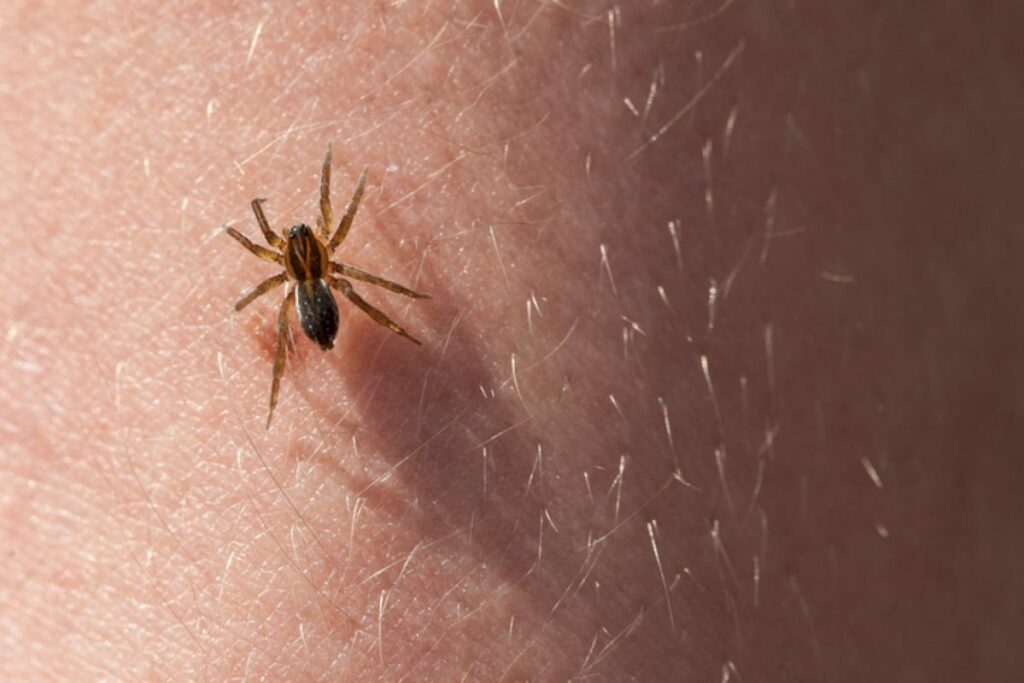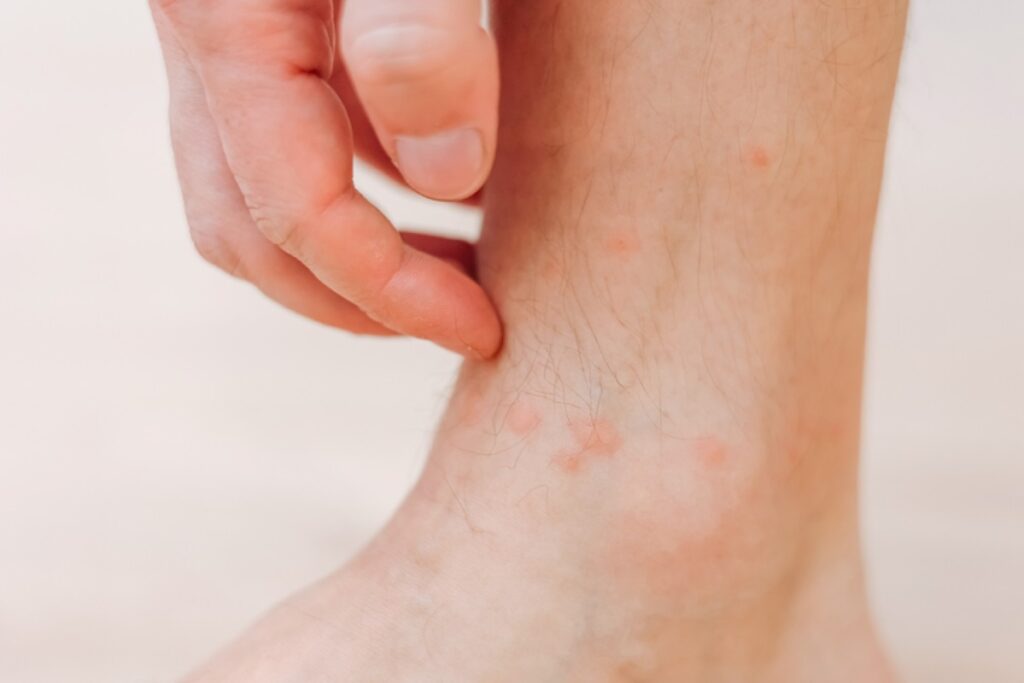How To Identify Different Bug Bites
Nobody wants to be bitten, but it’s an unfortunate fact of life that where there are people, there will be pests. While many unwanted visitors like crickets and spiders are intimidated by humans, several pests go out of their way to make a meal out of you. From identification and proactive prevention to how to avoid and relieve itchy bug bites, join us as we explore your guide to the most common types of biting pests.
Mosquito Bites

How To Distinguish Mosquito Bites From Other Pest Bites
While they are certainly noticeable on most people, mosquito bites can be tricky to distinguish from other pest bites, but there are subtle signs that can help you identify these stealthy buzzers. Unlike spider bites, mosquito bites usually appear as small, itchy, red welts with a central bump. Bedbug bites are often linearly clustered and may have a more severe reaction. Flea bites tend to be smaller and concentrated around the ankles, lower legs, while tick bites are usually noticed by the tick body hanging from the bite site. Ticks that have bitten and left unnoticed that infected the host with Lyme’s disease will frequently have a red bullseye-like rash. The key is to pay attention to the size, pattern, and associated symptoms to pinpoint the culprit. It is important to remember that many people do not react to certain insect bites.
What Are the Risks if Mosquitoes Bite Me?
Beyond the nuisance of itching, mosquito bites can pose significant health risks. Mosquitoes are vectors for various diseases, including West Nile, Zika, and dengue fever. Symptoms can range from mild discomfort to severe illness, depending on the virus transmitted.
While mosquitoes carry other less-than-lethal illnesses, it’s essential to monitor for symptoms such as fever, headache, and body aches after a mosquito bite, especially in areas where mosquito-borne diseases are prevalent.
If you have been bitten and have any concerns of infection, call a doctor. When it comes to these potentially deadly diseases, it is always better to stay safe than sorry.
How To Prevent Mosquitoes Around My Home
The two fundamental methods of mosquito prevention revolve around targeting their breeding grounds and minimizing their access to potential hosts. Eliminate standing water around your home, as container mosquitoes breed in stagnant water sources. Something the size of a bottle cap is sufficiently large to host a mosquito breeding site. Floodwater mosquitoes lay their eggs in muddy areas, so keep an eye out for depressions in the yard that collect excessive moisture and stay damp for extended periods.
Next, block their access points. Use screens on windows and doors to prevent entry into your living spaces, and for extra protection, install mosquito netting around outdoor areas to create a barrier between the pests and your property.
Keep in mind that you are their favorite food source. When outside, use insect repellents containing DEET and wear long sleeves and pants during peak mosquito activity times.
Spider Bites

How To Distinguish Spider Bites From Other Pest Bites
Spider bites often appear red, swollen, and itchy, with a central ulceration. While their symptoms may be similar, unlike mosquito bites, necrotic spider bites frequently have a bull’s-eye appearance, making them stand out. The presence of fang marks, which might be visible in the center, is a crucial feature to look for when identifying spider bites, so keep a close eye on your bite over time.
In most cases, spiders would rather flee than fight something hundreds of times their size. Spider bites are more likely to occur when a hand or foot is being placed into an area that backs a spider into a corner.
What Are the Risks if a Spider Bites Me?
While most spider bites cause mild reactions, being aware of venomous spiders is crucial. For example, the brown recluse and black widow can cause more severe symptoms you should be mindful of.
While non-venomous bites can still result in infections due to bacteria in spiders’ mouths, they are generally less severe. Pay attention to the bite’s development. Spider bites may progress to a larger, more painful sore compared to other pests. While some itching and discomfort are expected, you should not be experiencing nausea, fever, chills, or difficulty breathing from a typical spider bite.
Remember, if you exhibit any of the symptoms of a venomous bite, seek medical attention promptly.
How To Prevent a Spider Infestation in My Home
Spiders love dark and undisturbed areas, so keep living spaces clutter-free. To block entry points, seal cracks and crevices in walls and foundations to limit their access. To take care of any eggs or lone spiders already inside, regularly clean and vacuum corners, ceilings, and behind furniture. If you feel like getting creative, you can use a natural repellent like citrus or peppermint oil, which spiders find unpleasant, to deter them from creating webs in your home.
For larger spider infestations, it’s best to bring in the experts. Not only are we well equipped to remove spider colonies of all sizes, but the well-trained eye of a Rove Pest Control expert will help you understand the specific species of spider in your home so everyone can stay safe during our treatment and onward.
Bedbug Bites

How To Distinguish Bedbug Bites From Other Pest Bites
Many assume bedbug bites are the only bites that can appear overnight. While it is true that bedbugs wait in hiding places for you to go to sleep, other pests like mosquitoes and ticks are known to do the same. On top of that, these bites can take up to two weeks to appear, so being able to visually identify the signs is a must.
Bedbugs often leave a distinctive mark on your skin after they bite. Unlike the random patterns of mosquito or flea bites, bedbug bites tend to appear in clusters or lines. And while they may be similar in size and shape to ticks, bedbugs don’t burrow, so you won’t find a central puncture.
Commonly found on areas of your body in direct contact with bedding, like the face, neck, arms, and hands, these bites are usually small, red, and intensely itchy. Their tendency to develop into larger welts sets them apart from other pests’ bites. Keep an eye on the distinctive grouping and the location of the bites to identify these stealthy bloodsuckers.
What Are the Risks if Bedbugs Bite Me?
While bedbug bites are generally not harmful, the effects can extend beyond mere itching. Constant scratching can break the skin, leading to infections. But the true burden of bedbugs lies in the mental toll. Infestations of the nocturnal nuisances can cause anxiety, sleep disturbances, and even insomnia, so addressing the issue promptly is essential for your physical and mental well-being.
How To Prevent a Bedbug Infestation Around My Home
The first step in bedbug prevention is also the easiest: Be cautious and keep an eye out for places where you are most likely to pick up bed bugs. Beyond that, keep your bed and bedroom tidy. Regularly inspect your mattress, box springs, and bed frame for any signs of these nocturnal pests, and wash your sheets more frequently if you suspect their presence. You can also encase your mattress and box springs in bedbug-proof covers for a more effective shield and simplified inspection. .
Bedbugs are prevalent in high-traffic areas where multiple different people sleep. When traveling, inspect hotel rooms thoroughly, keep luggage off the floor, and be cautious when acquiring secondhand furniture or bedding, as these can harbor hidden bedbugs.
Call Rove Today!
Early detection and professional intervention are key to preventing an infestation of bedbugs and all other biting pests. With recurring treatments, strategic spot treatments, and preventive measures that provide ongoing protection, you can never be more sure that your home is protected from pests than when you choose Rove.
When pests bite, fight back with Rove at your side. Contact us to schedule your inspection today.